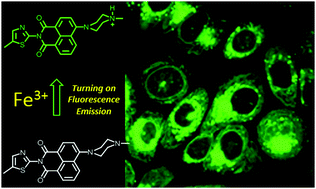当前位置:
X-MOL 学术
›
Chem. Commun.
›
论文详情
Our official English website, www.x-mol.net, welcomes your feedback! (Note: you will need to create a separate account there.)
Lysosomal tracking with a cationic naphthalimide using multiphoton fluorescence lifetime imaging microscopy
Chemical Communications ( IF 4.9 ) Pub Date : 2017-09-01 00:00:00 , DOI: 10.1039/c7cc05166b Meng Li 1, 2, 3, 4, 5 , Haobo Ge 1, 2, 3, 4 , Vincenzo Mirabello 1, 2, 3, 4 , Rory L. Arrowsmith 1, 2, 3, 4 , Gabriele Kociok-Köhn 1, 2, 3, 4 , Stanley W. Botchway 4, 6, 7, 8, 9 , Weihong Zhu 10, 11, 12, 13, 14 , Sofia I. Pascu 1, 2, 3, 4 , Tony D. James 1, 2, 3, 4
Chemical Communications ( IF 4.9 ) Pub Date : 2017-09-01 00:00:00 , DOI: 10.1039/c7cc05166b Meng Li 1, 2, 3, 4, 5 , Haobo Ge 1, 2, 3, 4 , Vincenzo Mirabello 1, 2, 3, 4 , Rory L. Arrowsmith 1, 2, 3, 4 , Gabriele Kociok-Köhn 1, 2, 3, 4 , Stanley W. Botchway 4, 6, 7, 8, 9 , Weihong Zhu 10, 11, 12, 13, 14 , Sofia I. Pascu 1, 2, 3, 4 , Tony D. James 1, 2, 3, 4
Affiliation

|
A naphthalimide-based chemosensing motif turns ON the fluorescence emission in solution in the presence of aqueous iron(III) chloride, and maintains this property in living cancer cells. The emission response to Fe(III) ions occurs simultaneously with a change in pH. The protonation of methyl piperazine-conjugated naphthalimide promotes its lysosomal localisation as assessed by co-localisation tests and fluorescence lifetime imaging microscopy (FLIM) in vitro.
中文翻译:

使用多光子荧光寿命成像显微镜用阳离子萘二甲酰亚胺追踪溶酶体
基于萘二甲酰亚胺的化学传感基序在氯化铁(III)水溶液存在下开启溶液中的荧光发射,并在活癌细胞中保持此特性。Fe(III)离子的发射响应与pH的变化同时发生。甲基哌嗪结合的萘二甲酰亚胺的质子化促进了其溶酶体定位,如体外共定位测试和荧光寿命成像显微镜(FLIM)所评估的。
更新日期:2017-09-22
中文翻译:

使用多光子荧光寿命成像显微镜用阳离子萘二甲酰亚胺追踪溶酶体
基于萘二甲酰亚胺的化学传感基序在氯化铁(III)水溶液存在下开启溶液中的荧光发射,并在活癌细胞中保持此特性。Fe(III)离子的发射响应与pH的变化同时发生。甲基哌嗪结合的萘二甲酰亚胺的质子化促进了其溶酶体定位,如体外共定位测试和荧光寿命成像显微镜(FLIM)所评估的。



























 京公网安备 11010802027423号
京公网安备 11010802027423号